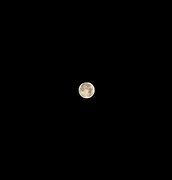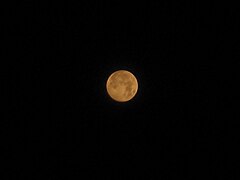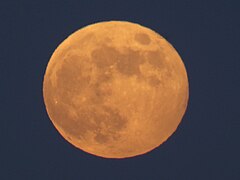
A partial lunar eclipse took place on 16 August 2008, the second of two lunar eclipses in 2008, with the first being a total eclipse on 20 February 2008. The next lunar eclipse was a penumbral eclipse occurring on 9 February 2009, while the next total lunar eclipse occurred on 21 December 2010.

A penumbral lunar eclipse took place on Monday, June 24, 2002, the second of three lunar eclipses in 2002. This penumbral eclipse was visibly imperceptible due to the small entry into the southern penumbral shadow.

A penumbral lunar eclipse took place on May 26, 2002, the first of three lunar eclipses in 2002.

A penumbral lunar eclipse took place at the Moon's ascending node on 11 February 2017, the first of two lunar eclipses in 2017. It was not quite a total penumbral lunar eclipse. It occurred the same day as comet 45P/Honda–Mrkos–Pajdušáková made a close approach to Earth. It also occurred on the Lantern Festival, the first since 9 February 2009. Occurring only 4.4 days after perigee, the moon's apparent diameter was larger.

A penumbral lunar eclipse took place on Thursday, June 27, 1991, the second of four lunar eclipses in 1991. The moon entered the Earth's penumbra for about 3 hours, and was difficult to see. This lunar eclipse is the predecessor of the Solar eclipse of July 11, 1991.
A penumbral lunar eclipse took place on Tuesday, May 15, 1984, the first of three lunar eclipses in 1984. This was a deep penumbral eclipse, with the southern limb of the Moon close to the Earth's shadow.
A penumbral lunar eclipse took place on Tuesday, January 20, 1981, the first of two lunar eclipses in 1981. In a rare total penumbral eclipse, the entire Moon was partially shaded by the Earth, and the shading across the Moon should have been quite visible at maximum eclipse. The penumbral phase lasted for 4 hours and 24 minutes in all, though for most of it, the eclipse was extremely difficult or impossible to see. The moon's apparent diameter was larger because the eclipse occurred 5.2 days after perigee.

A penumbral lunar eclipse took place on 10 January 2020. It was the first of four penumbral lunar eclipses in 2020. The moon’s apparent diameter was larger than average because occurred only 3 days before perigee and its distance was 375,887 km.

A penumbral lunar eclipse took place on 5 July 2020, the third of four lunar eclipses in 2020.

A penumbral lunar eclipse occurred on Friday, 5 May 2023, the first of two lunar eclipses in 2023. The moon's apparent diameter was 0.1% larger than average because it occurred 5.5 days before perigee. This was the deepest penumbral eclipse since February 2017 and until September 2042.

A partial lunar eclipse occurred on 19 November 2021. The eclipse occurred towards a micromoon. This was the longest partial lunar eclipse since 18 February 1440, and the longest until 8 February, 2669; however, many eclipses, including the November 2022 lunar eclipse, have a longer period of umbral contact at next to 3 hours 40 minutes. It was often referred to as a "Beaver Blood Moon" although not technically fulfilling the criteria for a true blood moon (totality).

A penumbral lunar eclipse took place on 30 November 2020. A penumbral lunar eclipse occurs at full moon when the Moon passes through Earth's penumbral shadow.

A penumbral lunar eclipse took place on Wednesday, May 4, 1966, the first of two penumbral lunar eclipses in 1966. It was visible from South America, Europe, Africa, Asia, Australia and Antarctica.
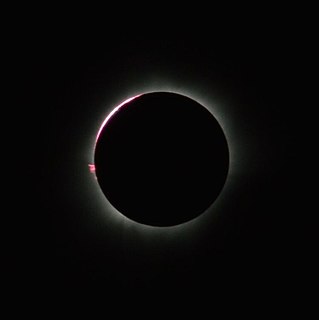
A total solar eclipse took place at the Moon's descending node of the orbit on March 8–9, 2016. If viewed from east of the International Date Line, the eclipse took place on March 8 (Tuesday) and elsewhere on March 9 (Wednesday). A total solar eclipse occurs when the Moon's apparent diameter is larger than the Sun's and the apparent path of the Sun and Moon intersect, blocking all direct sunlight and turning daylight into darkness; the sun appears to be black with a halo around it. Totality occurs in a narrow path across Earth's surface, with the partial solar eclipse visible over a surrounding region thousands of kilometres wide. The eclipse of March 8–9, 2016 had a magnitude of 1.0450 visible across an area of Pacific Ocean, which started in the Indian Ocean, and ended in the northern Pacific Ocean.

A penumbral lunar eclipse will take place on June 15, 2049.

A penumbral lunar eclipse will take place on March 3, 2045.

A total lunar eclipse will take place on March 13, 2044.
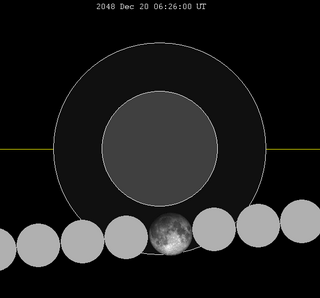
A penumbral lunar eclipse will take place on December 20, 2048.

A partial lunar eclipse will take place on June 26, 2048. The Moon will be strikingly shadowed in this deep partial eclipse lasting 2 hours and 39 minutes, with 63.88% of the Moon in darkness at maximum.

An annular solar eclipse occurred on Sunday, June 21, 2020. An annular solar eclipse is a solar eclipse whose presentation looks like a ring, or annulus; it occurs when the Moon's apparent diameter is smaller than the sun's, blocking most, but not all, of the sun's light. In this instance, the moon's apparent diameter was 0.6% smaller than the sun's.




